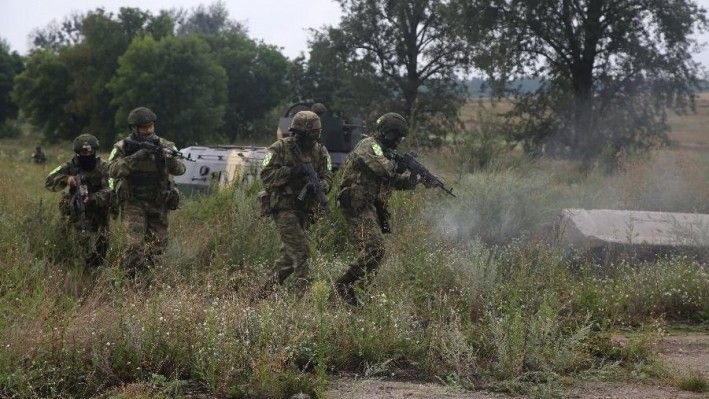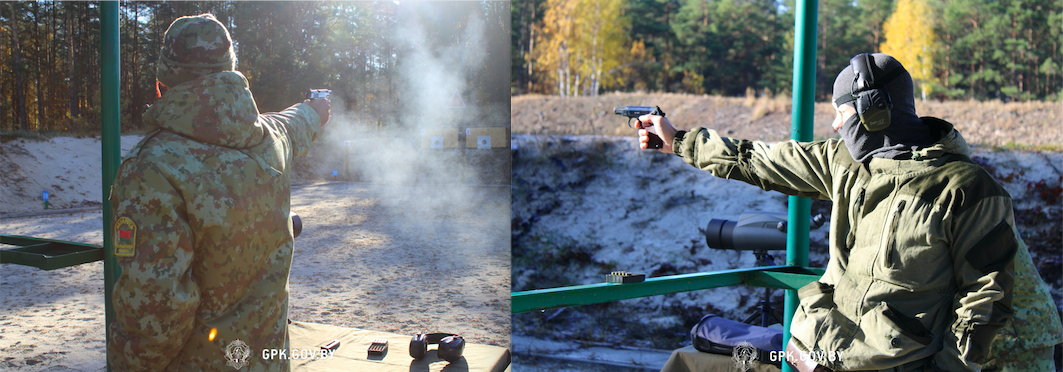Belarus: Militarisation of the Border Crisis

Militarisation of the migration crisis has become apparent, for a few weeks now. Even though there is a lot of information available on the Polish means and assets involved, one cannot say the same thing about the Belorussian side. We know that extra assets were deployed to the border to secure and finalize the Operation „Canal Lock” - to push the migrants through. Not only does the above refer to the State Border Guard, but also other services, subordinated to the Ministry of Internal Affairs, or even the MoD.
The observed Belorussian activities include:
- Tasks tied to securing of the border, with heightened levels of combat readiness;
- Monitoring, executing, and controlling the movement of the migrants, assaulting the technical means of security on the Polish, Latvian, and Lithuanian side, establishing camps;
- Securing the logistics;
- Securing the PSYOPS and information warfare;
- Carrying out provocative special operations;
- Providing the technical support measures, such as EW assets, jamming the communications near the border;
- Monitoring the Polish uniformed services with UAVs.
All of the activities are covert. The troops and officers wear no ID badges. The activities are justified by the necessity to mirror the actions of the neighbouring, aggressive states, including Poland. The whole narrative states that Poland and the Baltic States are responsible for the migration crisis, with the services being brutal against the migrants and with them carrying out non-humanitarian activities. The Belorussians accuse their neighbours of escalation, militarisation, and on-purpose provocations carried out at the border.
On 9th November, one of the releases issued by the Belarussian MoD stated that Poland's deploying 10 thousand soldiers to the Polish Belorussian border shall be viewed as a major military activity that threatens the bilateral relations and security in the region.
The military activity undertaken by Belarus is portrayed as self-defence. On 3rd August RIA Novosti published information suggesting that further Internal Troops and Army units are deployed to the border, to prevent "arms, drugs, and radicals" from entering the Belarus territory. Minsk presents the situation as a forced crisis, with the measures applied being required to seal the border from the threat posed by the EU.
Border Patrol's Role
The Border Patrol plays an important role in the crisis - not only are they responsible for securing the border, as they also know the area well, being able to direct migrants to areas that are not populated or not protected.
The structure of the Belorussian Border Guard includes territorial commands, border groups (Brest, Grodno), and border elements (Lida), etc. The Groups are divided into "Zastava" and "Komendatura" level elements. The Kuznica-Bruzgi border crossing is located in the Grodno Group's area of responsibility. Nonetheless, tensions grow on the borders with Poland, Lithuania, and Latvia at the same time.
The Border Groups are armed with Makarov pistols and AK rifles. Thus, sniper rifles or machine guns emerging in the vicinity have been worrying. The reinforcement in quantity and firepower has been apparent, since at least late August now. On 27th August, Guntis Pujats, head of the Latvian border authorities said that the Belorussian border patrol is now utilizing SVD sniper rifles and RPK machine guns.
"The risk levels are high, and we see that the Belorussian border service does not operate in a normal regime, being armed with serious weapons - sniper rifles, machine guns. This is a dangerous signal sent to the EU and NATO", Pujats said back then. The Latvians also emphasized the fact that Spetsnaz (ASAM/OSAM) units of the border guard, along with military SOF, are also patrolling the border, alongside the ordinary officers. Soon afterward, weapons as such, along with extra personnel, were also noticed by Poland. On 22nd September the Border Guard has published a couple of pictures showing men in uniforms, with a comment as follows: "The Officers of the Border Guard have been witnessing, for quite some time now, on the Belorussian side, along the Polish border, officers or soldiers who had not been present close to the border so far. The uniforms and kits they carry may suggest that they do not belong to the border service".

The new activity on the border has been worrying for Warsaw, with new units of the Belorussian services being present in the region. The presence of military reinforcement on the Belorussian side was confirmed by the spokesman for the Minister responsible for coordinating the intelligence services, Stanisław Żaryn. Żaryn also indicated as to why the situation is worrying and shall be monitored. "We see that there is an intent behind the situation created by the Lukashenko regime on the Polish-Belorussian border, there is some purpose behind the deployment of soldiers responsible for tasks different than border security." The spokesman, responding to questions regarding the kit carried by the Belorussian officers, said that no doubts emerge on those grounds. More worrying was the presence of troops equipped with sniper rifles. "This is a thing that suggests that persons whose tasks differ from border protection are deployed there by the Lukashenko's regime", Żaryn said. The recent video published by the Polish Ministry of Defence shows that the border patrol on the Belorussian side is also armed with RPG-7 anti-tank weapons. As that fact is not being hidden, it could be interpreted as a projection of power.
The Belorussian border patrol elements exhibit higher combat readiness, and their presence is rotational. Tactical reserves have also been, probably, prepared. Volat, UAZ, Ural, KamAZ, or MAZ vehicles are used to patrol the border and carry the personnel. Helicopters or armoured assets may also be used, in some specific cases. The border patrol uses the Groza-R2 man-portable counter-UAS system to intercept drone trafficking.
ASAM border guard Spetsnaz unit is the SOF asset that is responsible for border protection. It is also known under the Russian, acronym name - OSAM. OSAM translates into Special Service for Active Operations. It is dealing with counter-terrorism, and counter-extremism activities close to the border. Some suggest that these units may be directly involved in transporting the migrants across the border. OSAM tactical squad was involved in a joint exercise with the Grodno Border Group organized in August. The scenario trained included a collection of intelligence on illegal border crossing. To block and neutralize an armed group of criminals, the OSAM element was called to action.
Viktor Lukashenko, President's elder son, was serving in OSAM between 1998 and 2001. He attained the rank of a Captain.
Support from the Ministry of Internal Affairs
As the migrant channeling operation is directed at the governmental level, the management of the influx of people steps beyond the area of responsibility of the border patrol units. Other branches of the military or uniformed services subordinated to the Ministry of Internal Affairs need to be involved, Internal Troops and OMON included. Internal Troops or OMON were recently spotted near the border, along with trucks or offroad vehicles, sporadically employed to transport the migrants. The officers are on checkpoint duty - officially. One may assume that they also monitor and control the movement of migrants.
The reinforcements sent to the border by other departments and movement of forces and assets of the border patrol have been confirmed by the Belorussians. It was on 5th August, when official announcements were made that the Border would be reinforced by extra personnel at the outposts and patrol, with assets and personnel being moved from border sections of secondary importance. It is also relevant that it was stressed that the Border Guard has tightened its cooperation with the MoD and the Internal Troops, to form reserve and other elements.
The units subordinated to the Ministry of Internal Affairs (Internal Troops, OMON) include officers working close to the migration camps, wearing riot control uniforms.
During the movement of Migrants along the M6 route, from Grodno to Bruzgi-Kuźnica, the flow of people was controlled by the Border Guard with K9 elements, pushing the migrants from the road into the forest. Grodno OMON units were tasked with securing critical infrastructure, such as gas stations.
Vitaliy Satsukevitch, head for the Public Security matters at the Department of Internal Affairs of the Grodno Region Executory Committee was spotted near Kuznica. He is a trusted Lukashenko's connection. The movement and monitoring of migrants also involve the local police and OMON assets from Grodno. One could conclude that support for the border patrol, and the human resources, are provided by the 4th Separate Special Police Brigade, Military Unit no. 7404 from Baranoviche - two specific battalions in particular: Special Police Battalion from Grodno (5522) and Special Police Battalion from Brest (5526).
Local Reinforcements and Tactical Reserves
It is difficult to indicate what specific services support border security in Belarus. Local military elements would play the primary role here. For instance, back in August, a mechanized company of the Grodno 6th Mechanized Brigade was subordinated to the Grodno Border Group, during an operational-tactical exercise. The tactical element was involved in an exercise at the Hozha range, and it was formed by the Border authorities and the military unit. It also was reinforced by the reserve assets. Two Mi-8 helicopters and 3 BRDM-2 APCs were used here, among other assets.
It may be assumed that the military elements are expected to act as local reinforcement or tactical reserves.
It cannot be ruled out that MoD's units remain active in the field - Army Spetsnaz for instance - the 5th Spetsnaz Brigade. Information on training provided to Afghan and Iraqi rebels at the OSAM facility close to Opsa in North-Western Belarus is worrying and needs to be verified. Pavel Latushka, opposition member, former Belarus Ambassador to France and Poland, referring to highly ranked intelligence sources, is warning that the facility is used to train veterans from Afghanistan and Iraq to attack Poland, on the border. Commandos of the 5th Spetsnaz Brigade based in Marina Horka, subordinated to the MoD, are reportedly responsible for the training activities.
If no de-escalation happens, further militarisation of the border may be expected. The Belorussian narrative claims that the border patrol protects the border, preventing potential provocations. Thus, any further deployments would be portrayed as a necessity, to counteract the aggressive steps taken by Poland and Lithuania. Cynic as he is, Lukashenko claimed that Poland is deploying Leopard MBTs in the region, to neutralize the migrants. One should expect that further Belorussian reinforcements, including military presence, would be put into the narrative as a necessary step to counter-balance the excessive militarisation of the border on the Polish side.
It is difficult to predict the next stages of this scenario. One should not exclude further "soft" escalation, involving the presence of UAVs, helicopters, APCs, sniper teams, or "hard" escalation, with heavy armour and regular military presence. In extreme cases one may expect Russian activities, with FSB being present in the region - not to mention the military, if things go south even further.
Marcin Gawęda - Graduate of the Historical Institute of the Jagiellonian University, military historian, analyst, and expert on contemporary conflicts. Author of numerous articles in history-military, and military magazines. He wrote three books and three novels.

WIDEO: Defence24 Days 2025: Premier Defence & Security Conference in CEE